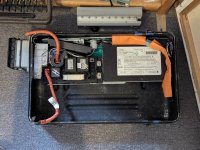Hypothetical pre-charge sequence for a 84v traction pack, HV contactors (p- w/resistor, m-, m+), HV:LV (84)dc:dc(13) converter, 12.4v accessory battery, and two LV amplification relays. Presently working on the wiring diagram for all this, so some help in elucidation is pending...
Sequence:
Hopefully... having the pre-charge governed by an accessory battery on isolated LV+ from the dc:dc output prevents the traction system from being active without the 'choke' pre-charge sequence. Ideally, this method also automatically cascade opens all HV connections inside the traction packs case if any interlock or fuse on the dc:dc is triggered.
Conceptual or applied improvements?
EDIT: Now seeing that having the key ignition closed to charge is, far from ideal. Need to revise that LV+ circuit path...
Sequence:
- OFF - All relays and contactors are open. No HV leaves the traction pack box that contains the battery modules, dc:dc, and HV junctions.
- PRECHARGE - Press a ST momentary switch (electrical choke) to connect the 12v accessory battery to a single LV amplification relay that drives both pre-charge contactors (-p and +).
- PRIMED - The (84)dc:dc(13) converter is unswitched on the pre-charge (and main) contactors output. So, once its input capacitor is saturated from the pre-charge (2.) an unswitched resistor and LED on it's 13v output illuminate, indicating the HV system is primed.
- HV ACTIVE - While primed (holding choke or while capacitors hold charge), dc:dc(13v) output to the ST key ignition is open, and when turning the key to close (start) power is sent to the main contactors (-, +).
- HV USE - while key ignition is closed a LV two-way latching toggle switch determines the route for 13v power to the contactors for discharge or recharge that has a third LV+ relay for the charger interlock.
- SHUTDOWN - Whenever key ignition switch is re-opened (off) the two main contactors open and the HV traction pack returns to isolated state (1.).
Hopefully... having the pre-charge governed by an accessory battery on isolated LV+ from the dc:dc output prevents the traction system from being active without the 'choke' pre-charge sequence. Ideally, this method also automatically cascade opens all HV connections inside the traction packs case if any interlock or fuse on the dc:dc is triggered.
Conceptual or applied improvements?
EDIT: Now seeing that having the key ignition closed to charge is, far from ideal. Need to revise that LV+ circuit path...
Last edited:




